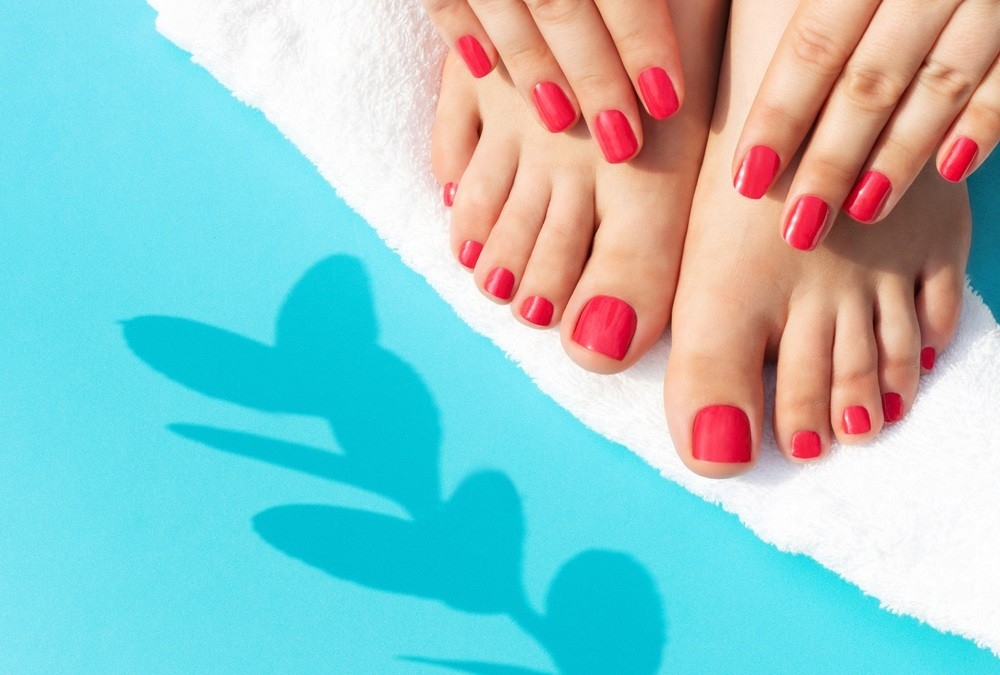Contents
- What is a Manicure?
- What is a Pedicure?
- Difference Between a Manicure and a Pedicure
- A Manicure and a Pedicure’s Similarities
- Importance of Manicure And Pedicures
- Benefits of Getting a Manicure and Pedicure
- Types of Manicures and Pedicures
- How long do a pedicure and manicure take?
- How much do a manicure and a pedicure cost?
- How often should you have Manicures and Pedicures?

What exactly is the distinction between a manicure and a pedicure? And what are the parallels?
Some people believe they are the same thing. There are, however, some notable changes!
Let’s talk about the difference between a manicure and a pedicure before you go to the nail salon or start doing one at home.
We’ll also go over some of the advantages frequent manicures and pedicures provide for your health since, well, they do!
What you should know about these two well-liked beauty procedures is provided here.
What is a Manicure?
Fingernails are trimmed, shaped, and polished during a manicure. However, if performed correctly, an at-home manicure can be just as effective if the correct tools are used, such as professional-grade nail clippers, cuticle pushers (to push back your cuticles), and nail files with varying degrees of coarseness to give your nails a variety of shapes, from square/oval to round/squoval.
Using an electric file would be a terrific idea to get that gleaming, smooth finish.
Depending on your taste, manicures can also be performed using nail polish. Due to their special training in application, a professional manicure can offer you color and gloss that lasts very long.
What is a Pedicure?
Your toenails are cleaned, shaped, and polished during routine pedicures. Like a manicure, at-home pedicures can be equally as effective if performed correctly using the right equipment, such as professional-grade nail clippers, cuticle pushers (to push back your cuticles), and nail files of various coarsenesses to shape your nails in a variety of ways, from square/oval to round/squoval).
Difference Between a Manicure and a Pedicure
So, what distinguishes a pedicure from a manicure? To begin with, these are two different treatments. The most noticeable distinction is that a pedicure is performed on the toes while a manicure is performed on the fingernails.
Each treatment has a particular goal in mind. For instance, a manicure often entails cuticle care, nail paint application, and trimming and shaping. The same procedure is used during a pedicure along with other therapies, including foot soaking, pumice stone or foot file use, application of a mask, and exfoliating foot scrub.
A Manicure and a Pedicure’s Similarities
There is, however, a link between the two approaches. Your nails should feel terrific and look excellent after any nail treatment. Because of this, you can anticipate that both a manicure and a pedicure will leave your fingernails and toes looking amazing.
A manicure or pedicure will assist in removing flaws from your nails, resulting in nails that look healthier. Even though obtaining a manicure or pedicure is regarded as a luxury, doing so has numerous health advantages in addition to the fact that you’re treating yourself.
Importance of Manicure And Pedicures
Your hands and feet are the parts of your body exposed to the most dirt, bacteria, and harsh weather regularly, making them more susceptible to injury. Manicures and pedicures can help by giving the appropriate care and attention in this situation.
Manicures and pedicures remove calluses from the feet and exfoliate the skin.
They keep your nails nice and clean, which lowers your risk of developing fungal illnesses.
With a quick at-home manicure, your nails will avoid cracking or chipping, which can be uncomfortable. Additionally, it guards against cracked skin, hangnails, and dry cuticles.
In time, the massage used during manicures and pedicures helps to reduce wrinkles on your hands by enhancing blood circulation.
Benefits of Getting a Manicure and Pedicure
Pedicure and manicure treatments have many advantages!
1. Remove Dead Skin
A manicure and pedicure both use an abrasive exfoliating substance to remove dead skin cells from your nails, resulting in smooth, lustrous, and healthy nails.
2. Reduce Ingrown Nails
By strengthening the health of your nails, regular manicures or pedicures by a skilled manicurist or nail technician can help reduce the chance of ingrown toenails.
Regular ingrown toenails are often the result of dead skin accumulation around the nails. By eliminating the dead skin by exfoliation and clipping away length from the nail to remove sharp edges, the likelihood of ingrown toenails can be considerably decreased.
3. Skin Benefits
Your skin’s general health and appearance can be enhanced with mani-pedi treatments. Your skin will be smoother, and the hand and foot massage will assist in improving blood circulation and avoiding fungus infections.
4. Nail Strength
By increasing blood flow, manicures and pedicures can strengthen thin nails; cutting, filing, and shaping your nails lowers your chance of breaking them.
5. It can make your hands and feet look younger
As manicures and pedicures improve blood flow, cellulite is reduced, skin tightens, and muscles are strengthened, all of which can enhance the outward appearance of your hands and feet.
6. Improved mental health
Whether it has been a busy day or week, taking the time to treat yourself to a manicure or pedicure will make you feel much less stressed. The massage, peaceful environment, and pampering will improve your mental health.
Types of Manicures and Pedicures
Manicure and pedicure treatments, such as American and French, come in various styles, such as American manicures, Classic manicures,…There are no right or incorrect answers because they are all personal opinions!
Shellac Manicure / Shellac Pedicure
“Shellac nails” refers to the 14-day-wear gel paint that was first created by the well-known nail company CND. In nail care, Shellac manicures and pedicures are a relatively new service form. Nevertheless, they have significantly grown in popularity in recent years due to their toughness. A shellac manicure, as the name suggests, is a procedure that strengthens and shines your nails by coating them in the gel.
The nails are hardened using an LED light or a UV lamp. If you want a color that lasts for a long time, choose Shellac nails. It’s essential to remember that this form of manicure may be better for persons with brittle nails.
Regular Manicure / Regular Pedicure
The more conventional choice is to have a regular manicure or pedicure. Warm water soaks the nails. They are shaped and trimmed, then polished with a base coat, standard polish, and top coat. This procedure may be the best option if you want to let your nails grow out for a while because it’s not too time-consuming.
French Manicure / French Pedicure
Applying white tips to the end of your fingernails and a light pink to the base gives your nails the classic French manicure appearance. It’s simple to perform at home on your own; a routine weekly manicure is needed to maintain the appearance of the tips (which will otherwise start to seem chipped).
If you enjoy doing something unusual with your nails, French pedicures are French manicures for the toes.
How long do a pedicure and manicure take?
Regular pedicures can take 45 minutes, but more elaborate ones that utilize gel paint, nail art, extensions, or other services like paraffin wax might take 60 to 90 minutes.
The length of a manicure can range from 20 minutes for a very straightforward manicure to 90 minutes for elaborate nail extensions.
How much do a manicure and a pedicure cost?
The price of manicures at nail salons varies depending on several factors, including your location and the service you desire.
The typical pricing range for a manicure is $25 to $75. Depending on the extras you choose for your nails, a simple manicure could cost you anywhere from $20 to $30. For superior manicure styles like acrylic and gel, anticipate paying $50 to $75.
Expect considerably higher prices if you choose sophisticated, opulent patterns and long-lasting manicure styles.
A pedicure will typically cost you between $35 and $60. You can pay between $15 and $35 for a pedicure when you use one of our specials. You should also give your nail technician a tip. Add roughly 15-20% to your total to determine the appropriate tip amount for a pedicure.
How often should you have Manicures and Pedicures?
Your lifestyle significantly impacts how frequently you get a manicure and pedicure. Naturally, your nails will require a little more care if your hands experience more daily wear and tear from your profession or activities. To keep your nails in excellent condition, experts advise waiting two to three weeks between manicures and pedicures. The cuticles and nails on your hands will start to dry out and become ragged within this period. The majority of nail polishes or coatings will also begin to chip.
However, maintaining your nails in good shape in between manicures is a terrific strategy to avoid frequent trips to the salon. Taking vitamins and minerals is a fantastic approach to caring for your nails.
For instance, keeping the skin around your nail and the surrounding region wet will retain flexibility and prevent peeling and dryness, which can quickly result in hanging nails. Apply a drop of your preferred fatty oil, such as argan or avocado oil, to your finger and toenail cuticles many times per day. You’ll never have to deal with the dangers of a hanging nail again, and your nail technician will appreciate you for it.
Numerous additional types of manicures and pedicures, including gel or dip manicures.
Overall, getting a manicure and pedicure is ideal for having shiny, healthy nails and making an excellent first impression! You will now be aware of the distinctions between manicures and pedicures and the advantages of each the next time you visit the nail salon or reach for your nail paint at home. Maby constantly updates new nail salons opening in the city with trending nail designs.
